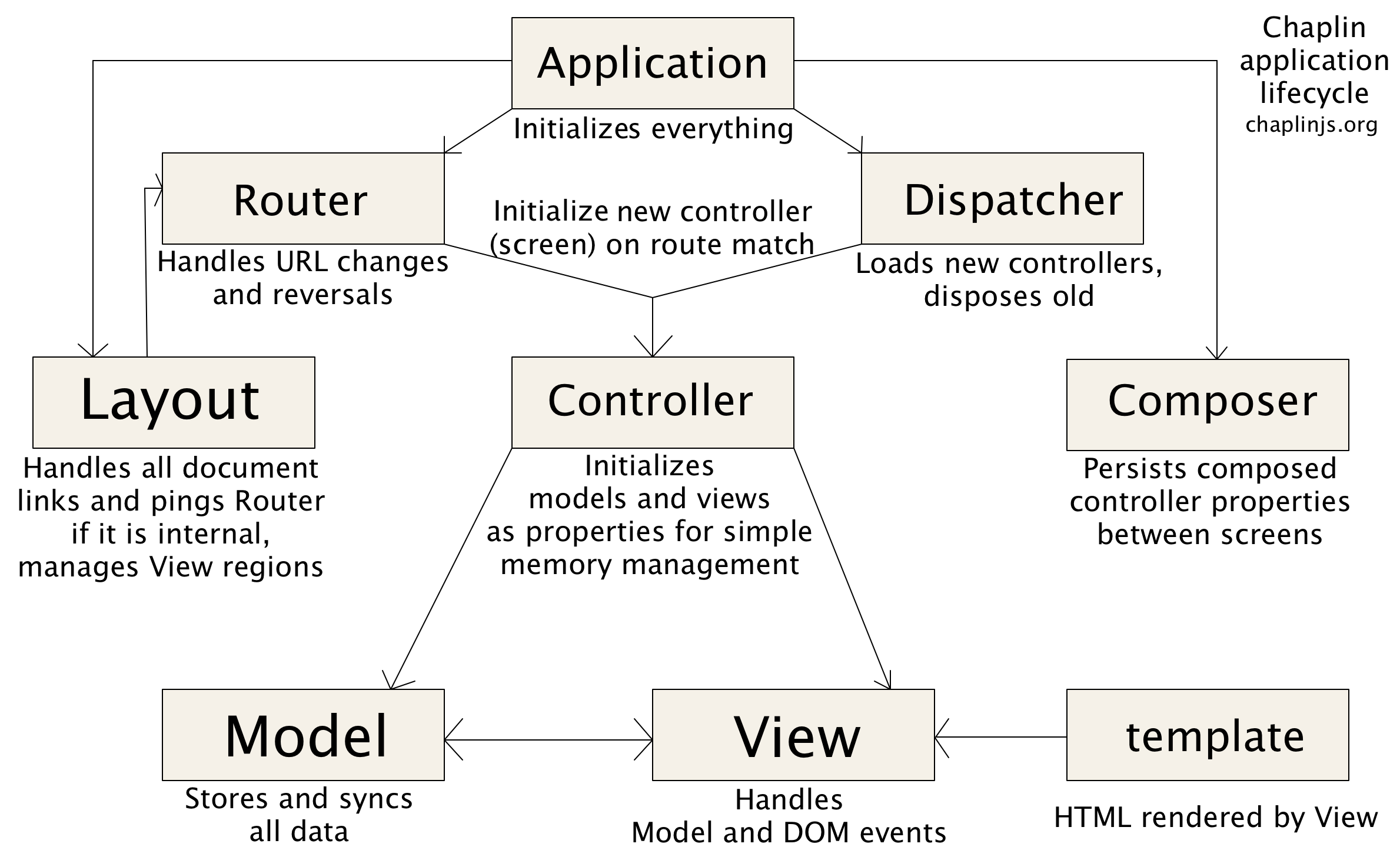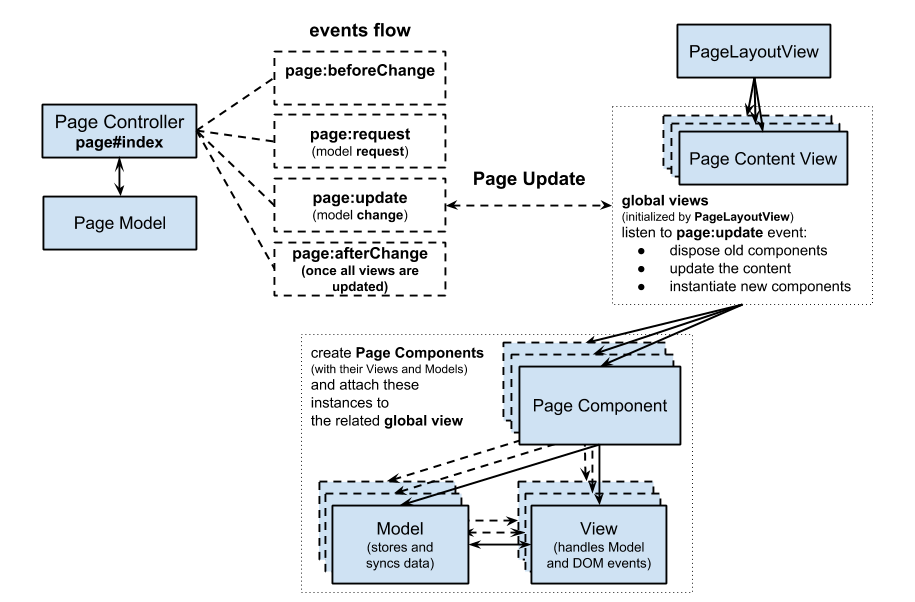Important
You are browsing upcoming documentation for version 6.1 of OroCommerce, scheduled for release in 2025. Read the documentation for version 6.0 (the latest LTS version) to get up-to-date information.
See our Release Process documentation for more information on the currently supported and upcoming releases.
JavaScript Architecture
Client-side architecture of Oro application is built on Chaplin architecture for JavaScript Web applications based on the Backbone.js library).
The Backbone provides little structure above simple routing, individual models, views and their binding. Chaplin addresses these limitations by providing a light-weight but flexible structure which leverages well-proven design patterns and best practices.
However, as we distribute functionality of some pages over multiple bundles (several bundles can extend a page with their own functionalities), we had to extend the Chaplin approach.
Technology Stack
Libraries used by OroPlatform on the client side:
jQuery + jQuery-UI
Bootstrap
Backbone + underscore
Chaplin
It is not the whole list, but only the main items that make the skeleton of the client.
Most of these libraries are placed in OroUIBundle (as the bundle which is
responsible for the user interface). Each of these libraries is defined
as a module in JS config with short module_id, so there is no need
to use the full path every time (e.g., the module_id is jquery instead
of oroui/lib/jquery).
Application
The application gets initialized by the oroui/js/app module that is entry point of webpack build.
This module exports an instance of the application (extension of Chaplin.Application); it depends on:
oroui/js/app/application, Application classoroui/js/app/routes, collection of routersconfiguration of
oroui/js/appand some app modules (optional)
Routes
Routes module (oroui/js/app/routes) is an array with only one route, which matches any URL and refers to the index method of controllers/page-controller:
[
['*pathname', 'page#index']
]
Application Configuration
Macros from @OroAsset/Asset.html.twig is utilized for passing options to the application’s constructor. The configuration is placed in @OroUI/js_modules_config.html.twig template:
{% import '@OroAsset/Asset.html.twig' as Asset %}
{{ Asset.js_modules_config({
'oroui/js/app': {
baseUrl: app.request.getSchemeAndHttpHost(),
headerId: oro_hash_navigation_header(),
userName: app.user ? app.user.username : null,
root: app.request.getBaseURL() ~ '\/',
publicPath: asset('build/')|split('?', 2)[0],
startRouteName: app.request.attributes.get('_master_request_route'),
debug: app.debug ? true : false,
skipRouting: '[data-nohash=true], .no-hash',
controllerPath: 'controllers/',
controllerSuffix: '-controller',
trailing: null
}
}) }}
It is placed in a twig-template in order to get access to backend variables in runtime, which is impossible to do in jsmodules.yml file.
Naming Conventions
File structures and naming conventions use best practices of Backbone development adopted for Oro needs.
Acme/Bundle/DemoBundle/Resources/public
├── css
│ └── style.css
├── templates // frontend templates
│ ├── projects
│ │ ├── project-item.html
│ │ └── projects-list.html
│ └── users
│ ├── user-item.html
│ └── users-list.html
├── js
│ ├── app // code that fully supports Chaplin architecture
│ │ ├── components
│ │ │ ├── view-component.js
│ │ │ └── widget-component.js
│ │ ├── controllers // Chaplin controllers
│ │ │ └── page-controller.js
│ │ ├── models
│ │ │ ├── projects
│ │ │ │ ├── project-model.js
│ │ │ │ └── projects-collection.js
│ │ │ └── users
│ │ │ ├── user-model.js
│ │ │ └── users-collection.js
│ │ ├── modules
│ │ │ ├── layout-module.js
│ │ │ └── views-module.js
│ │ └── views
│ │ ├── projects
│ │ │ ├── project-item-view.js
│ │ │ └── projects-view.js
│ │ └── users
│ │ ├── user-item-view.js
│ │ └── users-view.js
│ │ // utility code or other kind of architectural solutions
│ ├── app.js
│ ├── tools.js
│ └── ...
└── lib // for the third party libraries
├── jquery
│ └── jquery.min.js
├── backbone
│ └── backbone.min.js
└── underscore
└── underscore.min.js
Application Lifecycle
Chaplin extends Backbone concept introducing missing parts (such as a controller) and providing a solid life cycle for the application components:

As a result, a controller and all of its models and views exist only between the
navigation actions. Once the route is changed, the active controller gets disposed,
as well as all of its nested views and related models. A new controller is created
for the current route, and new views and models are created in the new
active controller. This approach of the limited life cycle of application components
solves memory leak issues. The rest of the components, such as the application itself,
router, dispatcher, layout, and composer (see the picture above)
exist all through the navigation.
To meet our needs, we had to extend this solution. In OroPlatform, a page content is defined by one bundle and might be extended by many other bundles. This way, there is no place where a client-side controller can be defined. As a solution, we have a common controller for all pages (PageController) that handles route changes and numerous small controllers (PageComponent) defined in the HTML and dedicated to certain feature implementation.
JS Templates (Underscore.js)
For Front-rendered templates, Oro applications use Underscore.js templates. JS templates belong to specific JS components defined as JS modules and can be overridden the same way as any other JS modules.
Fore more details see:
Page Layout View
Chaplin introduces Chaplin.Layout, which is the top-level application view.
The view is initialized for the body element and is kept in memory, even when the active
controller is changed. We have extended this approach and created PageLayoutView.
In addition to handling clicks on the application-internal links, it collects
form data and prepares navigation options for the AJAX POST request.
It also implements the ComponentContainer interface and initializes the top-level
Page Component defined in the page’s HTML.
This enables to create the so-called global views. These views are kept in the memory,
as well as PageLayoutView, when the active controller is changed.
Page Controller
The route module contains the only route mask that always leads to the PageController::index action point.
module.exports = [
['*pathname', 'page#index']
];
This way, the disposed and created controllers for each navigation action are instances of the same constructor, which exists in different life cycles of the application.
This PageController loads the page content over PageModel and sends a
series of system events to notify the environment that the page content has changed.
Note
The page update flow contains the following system events:
page:beforeChange
page:request
page:update
page:afterChange

These events are handled by global views (views and components that exist throughout
the navigation and are not deleted by the page change. See
Page Layout View for more information).
One of them is PageContentView that listens to page:update and updates
page content area with HTML from PageModel.
Page Component
As the functionality of a page depends on its content, and this content is generated by multiple bundles, we cannot use a single controller to be responsible for it. We have introduced an alternative approach that enables to use multiple controllers, each of which is responsible for certain functionality and is related to a certain part of the HTML.
Such controllers are called a Page Component. Functionally, a “Page Component” is similar to the “Controller” component in Chaplin, however, it implements a different flow:
The “Controller” represents one screen of the application and is created when the page URL is changed
The “Page Component” represents part of the page with certain functionality and is created in the course of page processing, subject to the settings declared in the HTML.
Define a Page Component
To define PageComponent for a block, specify the following two
data-attributes in the HTML node:
data-page-component-module— the name of the moduledata-page-component-options— a safe JSON-string
{% set options = {
metadata: metaData,
data: data
} %}
<div data-page-component-module="mybundle/js/app/components/grid-component"
data-page-component-options="{{ options|json_encode }}"></div>
How It Works
The PageController loads a page and, thus, triggers the page:update event.
Global views (see Page Layout View)
handle the event and update its HTML content. After that, views invoke the initLayout
method. It performs a series of actions to its element. One of the actions is
initPageComponents. This method performs the following:
collects all the elements with proper data-attributes
loads defined modules of PageComponents
executes the init method with the received options to initialize the PageComponents
resolves the initialization promise with the array of components after all components initialization
The PageController collects all promises from page:update event handlers,
and once all of them are resolved, it triggers the page:afterChange event.
See also
For more details, see the Page Component documentation.
App Module
App Modules are atomic parts of the general application, and they are responsible for the following:
register handlers in
mediator(see Chaplin.mediator )subscribe to the mediator events
perform all the preliminary actions before an instance of the application is created
App modules export nothing. They are the callback functions executed before launching the application. They make the whole application modular and the functionality distributed among the bundles ready to work.
App Modules are declared in the jsmodules.yml configuration file in the custom app-modules section:
app-modules:
- oroui/js/app/modules/messenger-module
This way, you can define the code to be executed at the application start for every bundle.
An example of using App Modules is provided in the section below.
Example
oroui/js/app/modules/messenger-module declares handlers of the messenger in mediator.
import mediator from 'oroui/js/mediator';
import messenger from 'oroui/js/messenger';
/**
* Init messenger's handlers
*/
mediator.setHandler('showMessage',
messenger.notificationMessage, messenger);
mediator.setHandler('showFlashMessage',
messenger.notificationFlashMessage, messenger);
/* ... */
This way, we guarantee that all the necessary handlers are declared before they are used. The handlers can be executed by any component or view in the Chaplin life cycle.
mediator.execute('showMessage', 'success', 'Record is saved');
See also
For more details, see Chaplin documentation.
Business Tip
Curious to learn more about B2B e-commerce and how it’s different from B2C? Read our comprehensive guide on this topic.
Related Topics